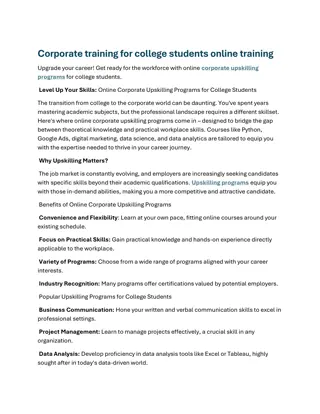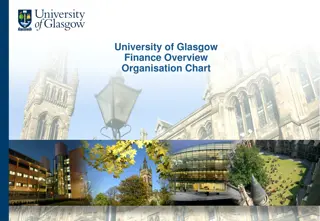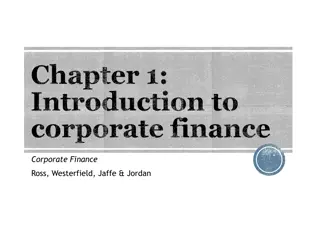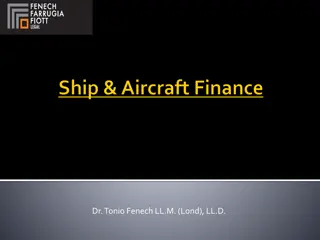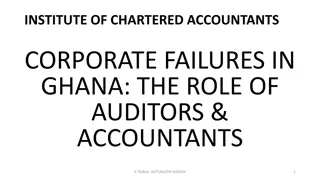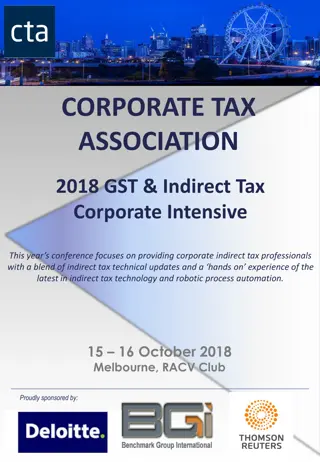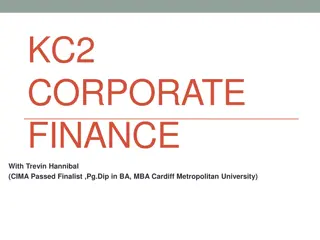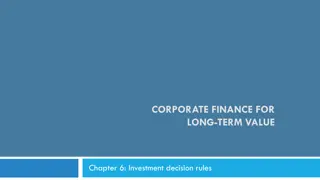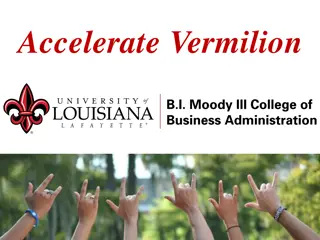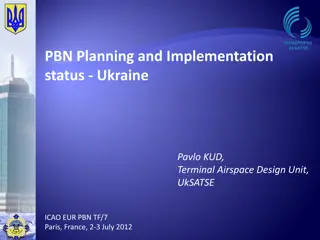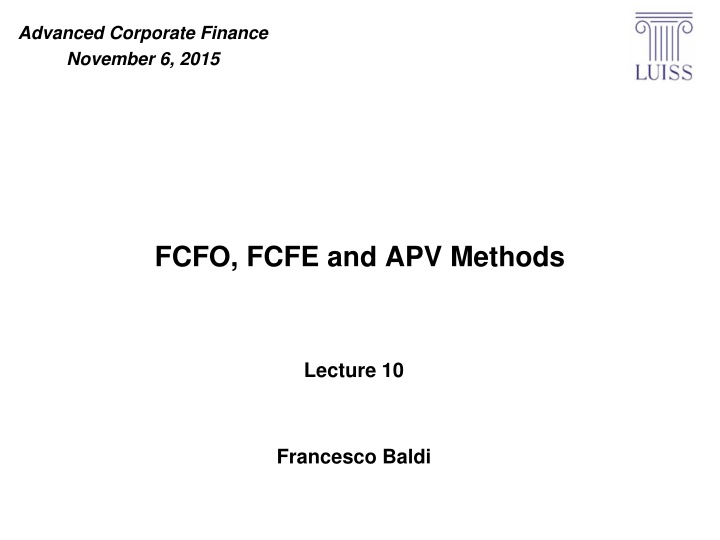
Corporate Finance Valuation Methods Overview
Explore different valuation methods in corporate finance such as WACC, APV, and FTE. Understand how interest tax shields, debt-equity ratios, and market risks impact project and firm valuation decisions. Dive into the details of using the Weighted Average Cost of Capital (WACC) method to value a project, with a practical example of evaluating a new product line.
Download Presentation

Please find below an Image/Link to download the presentation.
The content on the website is provided AS IS for your information and personal use only. It may not be sold, licensed, or shared on other websites without obtaining consent from the author. If you encounter any issues during the download, it is possible that the publisher has removed the file from their server.
You are allowed to download the files provided on this website for personal or commercial use, subject to the condition that they are used lawfully. All files are the property of their respective owners.
The content on the website is provided AS IS for your information and personal use only. It may not be sold, licensed, or shared on other websites without obtaining consent from the author.
E N D
Presentation Transcript
Advanced Corporate Finance November 6, 2015 FCFO, FCFE and APV Methods Lecture 10 Francesco Baldi
Project/Firm Valuation: 3 Methods Because interest payments are deductible as an expense for the corporation, debt financing creates a valuable interest tax shield for the firm. We can include the value of this tax shield in the capital budgeting decision in several ways. WACC method, in which we discount the unlevered free cash flows using the weighted average cost of capital, or WACC. Alternatively we can use the APV method in which we explicitly add the vale of the interest tax shields to the project s unlevered value. Rather than value the firm based on its free cash flows, we can also value its equity based on the total payouts to shareholders, the FTE method. Assumptions: The project has average risk. We assume that the market risk of the project is equivalent to the average market risk of the firm s investments. In that case, the project s cost of capital can be assessed based on the risk of the firm. The firm s debt-equity ratio is constant. Initially, we consider a firm that adjusts its leverage to maintain a constant debt-equity ratio in terms of market values. This policy determines the amount of debt the firm will take on when it accepts a new project. Corporate taxes are the only imperfection. We assume initially that the main effect of leverage on valuation is due to the corporate tax shield. 2
The Weighted Average Cost of Capital Method The WACC method takes the interest shield into account by using the after-tax cost of capital as the discount rate. When the market risk of the project is similar to the average market risk of the firm s investments, then its cost of capital is equal to the firm s weighted average cost of capital (WACC). E + D + = + (1 ) wacc r r r E D c E D E D For now, it is assumed that the firm maintains a constant debt-equity ratio and that the WACC remains constant over time. 3
The Weighted Average Cost of Capital Method Because the WACC incorporates the tax savings from debt, we can compute the levered value of an investment, by discounting its future free cash flow using the WACC. FCF + FCF + FCF + = + + + L 3 V 1 2 0 2 3 1 (1 ) (1 ) wacc r wacc r wacc r 4
Using the WACC to Value a Project Assume Avco is considering introducing a new line of packaging, the RFX Series. Avco expects the technology used in these products to become obsolete after four years. However, the marketing group expects annual sales of $60 million per year over the next four years for this product line. Manufacturing costs and operating expenses are expected to be $25 million and $9 million, respectively, per year. 5
Using the WACC to Value a Project Developing the product will require upfront R&D and marketing expenses of $6.67 million, together with a $24 million investment in equipment. The equipment will be obsolete in four years and will be depreciated via the straight-line method over that period. Avco expects no net working capital requirements for the project. Avco pays a corporate tax rate of 40%. 6
Spreadsheet Expected Free Cash Flow from Avco s RFX Project 7
Avcos Current Market Value Balance Sheet ($ million) and Cost of Capital Without the RFX Project 8
Avcos Current Market Value Balance Sheet ($ million) and Cost of Capital Without the RFX Project Avco intends to maintain a similar (net) debt-equity ratio for the foreseeable future, including any financing related to the RFX project. Thus, Avco s WACC is 300 600 300 600 E + D + = + = + (1 ) (10%) (6%)(1 0.40) wacc r r r E D c E D E D = 6.8% Note that net debt = D=320-20=$300 million. The value of the project, including the tax shield from debt, is calculated as the present value of its future free cash flows. 18 18 18 18 = + + + = L $61.25 million V 0 2 3 4 1.068 1.068 1.068 1.068 The NPV of the project is $33.25 million $61.25 million $28 million = $33.25 million 9
Summary of the WACC Method 1. Determine the free cash flow of the investment. 2. Compute the weighted average cost of capital. 3. Compute the value of the investment, including the tax benefit of leverage, by discounting the free cash flow of the investment using the WACC. The WACC can be used throughout the firm as the companywide cost of capital for new investments that are of comparable risk to the rest of the firm and that will not alter the firm s debt-equity ratio. 10
Example 1 11
Implementing a Constant Debt-Equity Ratio By undertaking the RFX project, Avco adds new assets to the firm with initial market value $61.25 million. Therefore, to maintain its debt-to-value ratio, Avco must add $30.625 million in new debt. 50% 61.25 = $30.625 Avco can add this debt either by reducing cash or by borrowing and increasing debt. Assume Avco decides to spend its $20 million in cash and borrow an additional $10.625 million. Because only $28 million is required to fund the project, Avco will pay the remaining $2.625 million to shareholders through a dividend (or share repurchase). $30.625 million $28 million = $2.625 million 12
Avcos Current Market Value Balance Sheet ($ million) with the RFX Project 13
Implementing a Constant Debt-Equity Ratio The market value of Avco s equity increases by $30.625 million. $330.625 $300 = $30.625 Adding the dividend of $2.625 million, the shareholders total gain is $33.25 million. $30.625 + 2.625 = $33.25 Which is exactly the NPV calculated for the RFX project 14
Implementing a Constant Debt-Equity Ratio What happens over the life of the project? First we define: Debt Capacity The amount of debt at a particular date that is required to maintain the firm s target debt-to-value ratio. The debt capacity at date t is calculated as: = L d D V t t Where dis the firm s target debt-to-value ratio and VLt is the levered continuation value on date t. 15
Implementing a Constant Debt-Equity Ratio Debt Capacity VLt calculated as: Because the continuation value at each date includes the value of all subsequent cash flows, it is even simpler to compute the value at each date by working backward: + Value of in year 2 and beyond t V + FCF + L FCF = L 1 + 1 t t V t + 1 wacc r 16
Continuation Value and Debt Capacity of the RFX Project over Time 17
Example 2 18
The Flow-to-Equity Method In the WACC and APV methods, we value the project based on its free cash flow, which is computed ignoring interest and debt payments. Flow-to-Equity A valuation method that calculates the free cash flow available to equity holders taking into account all payments to and from debt holders The cash flows to equity holders are then discounted using the equity cost of capital. 19
Calculating The Free Cash Flow-to-Equity Free Cash Flow to Equity (FCFE) The free cash flow that remains after adjusting for interest payments, debt issuance and debt repayments The first step in the FTE method is to determine the project s free cash flow to equity. 20
Expected Free Cash Flows to Equity from Avco s RFX Project 21
Calculating the Free Cash Flow to Equity Note two changes in the calculation of the free cash flows. Interest expenses are deducted before taxes. The proceeds from the firm s net borrowing activity are added in. These proceeds are positive when the firm issues debt and are negative when the firm reduces its debt by repaying principal. = Net Borrowing at Date t D D 1 t t 22
Computing FCFE from FCF for Avcos RFX Project The FCFE can also be calculated, using the free cash flow, as = + (1 ) (Interest Payments) (Net Borrowing) FCFE FCF c After-tax interest expense The project s FCFE is lower than its FCF in years 1 through 4 due to interest and pricipal payments on the debt. In year 0, however the proceeds, from the loan more tahn offset the negative cash flow, so FCFE is postive. 23
Valuing Equity Cash Flows Because the FCFE represent payments to equity holders, they should be discounted at the project s equity cost of capital. Given that the risk and leverage of the RFX project are the same as for Avco overall, we can use Avco s equity cost of capital of 10.0% to discount the project s FCFE. 9.98 1.10 9.76 1.10 9.52 1.10 9.27 1.10 = + + + + = ( ) 2.62 $33.25 million NPV FCFE 2 3 4 The value of the project s FCFE represents the gain to shareholders from the project and it is identical to the NPV computed using the WACC and APV methods. 25
Valuing Equity Cash Flows (2) Why isn t the project s NPV lower now that we have deducted interest and debt payments from the cash flows? It must be considered that these costs of debt are offset by cash received when the debt is issued. In FCFE projections table, the debt cash flows in lines 7 and 14 have an NPV equal to zero (= 0) assuming the debt is fairly priced . Because the debt cash flows have the same risk as the debt, we discount them at the cost of debt capital (6%) to compute their NPV: In the end, the only effect on value comes from a reduction in the tax payments, leaving the same result as with the other methods. 26
Summary of the Flow-to-Equity Method 1. Determine the free cash flow to equity of the investment. 2. Determine the equity cost of capital. 3. Compute the equity value by discounting the free cash flow to equity using the equity cost of capital. 27
Summary of the Flow-to-Equity Method The FTE method offers some advantages. It may be simpler to use when calculating the value of equity for the entire firm, if the firm s capital structure is complex and the market values of other securities in the firm s capital structure are not known. It may be viewed as a more transparent method for discussing a project s benefit to shareholders by emphasizing a project s implication for equity. The FTE method has a disadvantage associated with the APV approach: One must compute the project s debt capacity to determine the interest and net borrowing before capital budgeting decisions can be made. For this reason, in most settings the WACC is easier to apply. 28
The Adjusted Present Value Method Adjusted Present Value (APV) A valuation method to determine the levered value of an investment by first calculating its unlevered value and then adding the value of the interest tax shield. = = + L U (Interest Tax Shield) V APV V PV The (APV) method incorporates the value of the interest tax shield directly, rather than by adjusting the discount rate as in the WACC method. 29
The Unlevered Value of the Project The first step in the APV method is to calculate the value of the free cash flows using the project s cost of capital if it were financed without leverage. Unlevered Cost of Capital The cost of capital of a firm, were it unlevered: for a firm that maintains a target leverage ratio, it can be estimated as the weighted average cost of capital computed without taking into account taxes (pre-tax WACC). E + D + = + = Pretax WACC r r r U E D E D E D We value the interest tax shield separately. 30
The Unlevered Value of the Project The firm s unlevered cost of capital equals its pretax WACC because it represents investors required return for holding the entire firm (equity and debt). This argument relies on the assumption that the overall risk of the firm is independent of the choice of leverage. The tax shield will have the same risk as the firm if the firm maintains a target leverage ratio. 31
The Relationship between Pre-Tax WACC and Unlevered Cost of Capital Let us derive the relationship between the levered and unlevered cost of capital for the firm. Suppose an investor holds (a) a portfolio of all the equity and debt of the firm. Then, the investor will receive the free cash flows of the firm plus the tax savings from the interest tax shield. These are the same cash flows an investor would receive from (b) a portfolio of the unlevered firm (which generates the free cash flows) and a separate taxshield security that paid the investor the amount of the tax shield each period. Because these 2 portfolios generate the same cash flows, by the Law of One Price, they have the same market values: where T is the present value of the interest tax shield. The above equation is the basis of the APV method. 32
The Relationship between Pre-Tax WACC and Unlevered Cost of Capital (2) Because these portfolios have equal cash flows, they must also have identical expected returns, which implies: where is the expected return associated with the interest tax shields. The relationship between will depend on the expected return , which is determined by the risk of the interest tax shield. Suppose the firm adjusts its debt continuously to maintain a target debt-to-value ratio. Because the firm s debt and interest payments will vary with the firm s value and cash flows, it is reasonable to expect the risk of the interest tax shield will equal that of the firm s free cash flow, so Making this assumption, the previous equation becomes: 33
The Relationship between Pre-Tax WACC and Unlevered Cost of Capital (3) Dividing both sides of the last equation by we obtain: 34
The Unlevered Value of the Project Target Leverage Ratio When a firm adjusts its debt proportionally to a project s value or its cash flows (where the proportion need not remain constant) A constant market debt-equity ratio is a special case. 35
The Unlevered Value of the Project For Avco, its unlevered cost of capital is calculated as: = + = 0.50 10.0% 0.50 6.0% 8.0% Ur The project s value without leverage is calculated as: 18 1.08 18 18 18 = + + + = U $59.62 million V 2 3 4 1.08 1.08 1.08 36
The Unlevered Value of the Project The value of $59.62 million is the value of the unlevered project and does not include the value of the tax shield provided by the interest payments on debt. = Interest paid in year D r t D 1 t The interest tax shield is equal to the interest paid multiplied by the corporate tax rate. 37
Expected Debt Capacity, Interest Payments, and Tax Shield for Avco s RFX Project 38
Expected Debt Capacity, Interest Payments, and Tax Shield for Avco s RFX Project To compute the present value of the interest tax shield, we need to determine the appropriate cost of capital. The interest tax shields shown in table are expected value, and the true amount of interest tax shield each year will vary with the cash flows of the project. The next step is to find the present value of the interest tax shield. When the firm maintains a target leverage ratio, its future interest tax shields have similar risk to the project s cash flows, so they should be discounted at the project s unlevered cost of capital. 0.73 1.08 0.57 1.08 0.39 1.08 0.20 1.08 = + + + = (interest tax shield) $1.63 million PV 2 3 4 39
Valuing the Interest Tax Shield The total value of the project with leverage is the sum of the value of the interest tax shield and the value of the unlevered project. = + = + = L U (interest tax shield) 59.62 1.63 $61.25 million V V PV The NPV of the project is $33.25 million $61.25 million $28 million = $33.25 million This is exactly the same value found using the WACC approach. 40
APV: Solving for Leverage and Value Simultaneously When we use the APV method, we need to know the debt level to compute the interest tax shield and determine the project s value. But if a firm maintains a constant debt-to-value ratio, we need to know the project s value to determine the debt level. How can we apply the APV method in this case? When a firm maintains a constant leverage ratio, to use the APV method we must solve for the debt level and the project value simultaneously. While complicated to do by hand, it is easy to do in Excel. Let us look at the previous Table, which illustrates the standard APV calculation, where we have just inserted arbitrary values for the project s debt capacity (in line 3). 41
APV: Solving for Leverage and Value Simultaneously (2) The debt capacity specified in line 3 is not consistent with a 50% debt-to-value ratio for the project. For example, given the value of $60.98 million in year 0, the initial debt capacity should be 50% x $60.98 million = $30.49 million in year 0. But if we change each debt capacity in line 3 to a numerical value that is 50% of the value in line 7, the interest tax shield and the project s value will change, and we will still not have a 50% debt-to-value ratio. The solution is to enter in line 3 a formula that sets the debt capacity to be 50% of the project s value in line 7 in the same year. Now line 7 depends on line 3, and line 3 depends on line 7, creating a circularreference in the spreadsheet. By changing the calculation option in Excel to calculate the spreadsheet iteratively (Excel 2003: Tools > Options menu > Calculation Tab, and check the Iteration box) (Excel 2007: Excel Options > Formulas, and check the Enable iterative calculation box), Excel will keep calculating until the values in lines 3 and 7 of the spreadsheet are consistent: 42
APV: Solving for Leverage and Value Simultaneously (3) 43
Summary of the APV Method 1. Determine the investment s value without leverage by discounting its free cash flows at the unlevered cost of capital. 2. Determine the present value of the interest tax shield. a. Determine the expected interest tax shield. b. Discount the interest tax shield. 3. Add the unlevered value to the present value of the interest tax shield to determine the value of the investment with leverage. 44
Summary of the APV Method The APV method has some advantages. It can be easier to apply than the WACC method when the firm does not maintain a constant debt-equity ratio. The APV approach also explicitly values market imperfections and therefore allows managers to measure their contribution to value. 45
Example 3 46
Example 3 47







